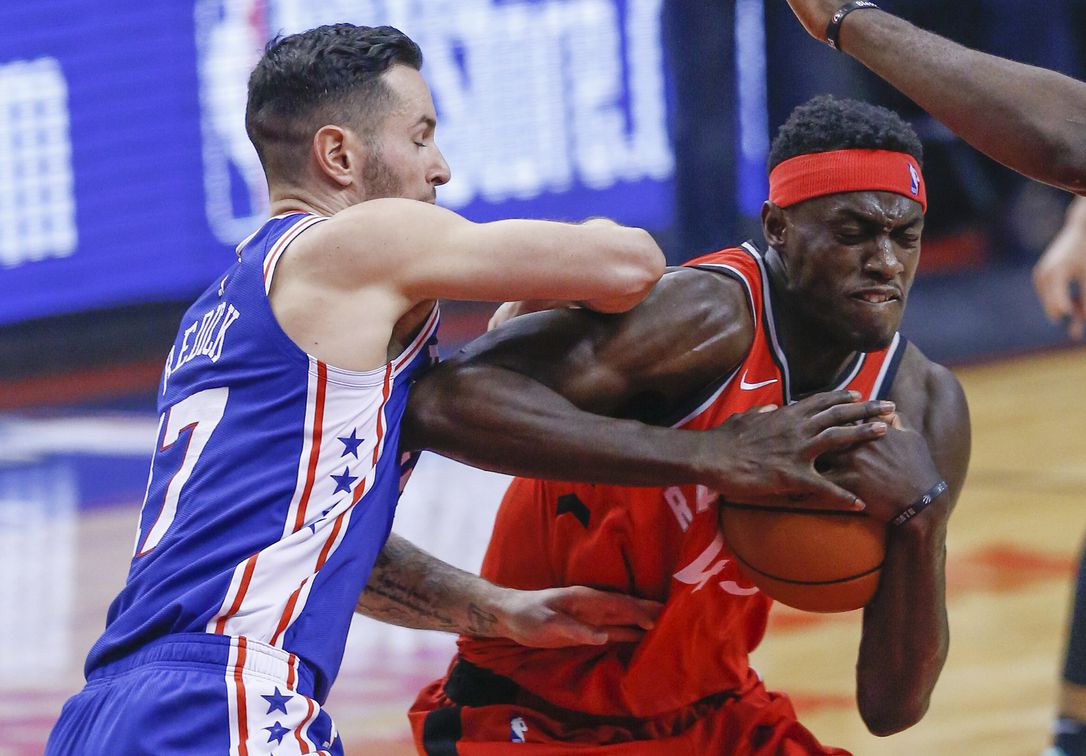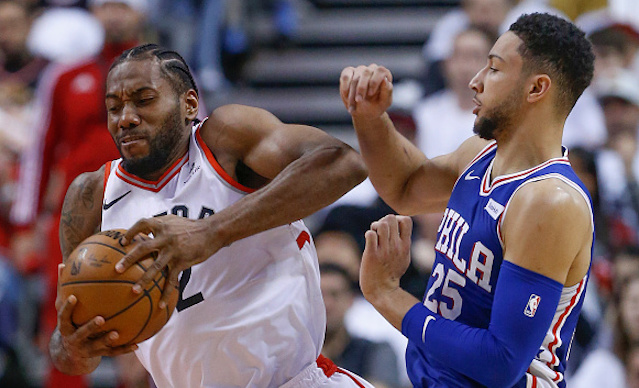Last year I had a university professor that lived for tricking his students. Maybe I should have just studied more – most likely the real moral of this story – but I had diligently gone through his study guide prior to his famously dreaded final exam. Once I sat down that fateful morning and turned the opening page, I knew he had deceived me. The entire exam could’ve been written in Italian for all I cared. I was shook.
The Raptors looked similarly bumpuzzled when facing the new defensive matchups that Philadelphia presented on Monday night.
The new picture that the Sixers showed was confusing to be sure, it rattled the Raptors to such a degree that they fell to a double digit deficit by halftime. Philadelphia applied far more pressure on Kawhi Leonard after his roasting of them a few nights earlier and placed their Defensive Player of the Year candidate on Pascal Siakam. Amidst this chaotic opening half, Toronto forgot about the Sixers biggest weakness on the defensive end, JJ Redick.
On their first eight offensive possessions, Toronto did nothing to attack Redick. Redick, who is primarily guarding Danny Green, was allowed to drift on the perimeter free of pressure. Now, the Raptors were clearly probing the new defensive scheme that the Sixers put forth and were running their offensive through their best players which is, of course, a good thing. Green is on the floor to space, despite his rough 31.6 per cent outside shooting this postseason, not because of his playmaking abilities. Still, of the 56 possessions Redick has defended Green thus far, he has only mustered three field goal attempts, per NBA.com.
The Raptors cannot simply let Redick off the hook. When the Cavaliers upended Golden State in 2016, LeBron James tirelessly sought out Steph Curry. Likewise, many of the Boston Celtics opponents search for Kyrie Irving and bring him into the eye of the defensive storm. Hunting Redick is not a like-for-like situation as Philadelphia are incredibly averse to switching pick-and-rolls, but the point still remains: when margins become increasingly thin teams must seek and exploit their opponents’ weaknesses.
And Redick is definitely a weakness. Throughout the regular season Redick’s opponents shot better against him than their season average from every distance, including a ludicrous 70.9 per cent from within six feet. During these playoffs, Redick is allowing 1.36 points per possession when defending in isolation and fouls in those instances 36 per cent of the time. Those marks are fifth and fourth worst in the league.
On the Raptors’ ninth possession, they finally brought Redick into the fray. Green sets a ball screen for Lowry and the defensive duo of Redick and Jimmy Butler immediately miscommunicated to allow Lowry a wide open look from three:
The only other time that Toronto tested Redick in the first quarter was an ugly pull-up jumper by Norman Powell. The look was unscripted and late in the shot clock with Redick flanked by Embiid and Jonah Bolden to help down low. Not great, but attacking Redick off of the dribble is a tasty option. It seems logical given Redick’s slight build but achieving this is tougher in practice due to their shot-blocking machine lurking at all times. Right now Toronto are only attempting 5.5 shot attempts a game against Redick at a grossly underwhelming 27.3 per cent. During the regular season, they 8.3 attempts per game against him at a far more efficient rate.
Due to Nick Nurse’s refusal to respond to Phladelphia’s unorthodox rotations (ugh), Redick has been afforded a nice chunk of minutes against the Raptors bench. In game two Redick was able to log over 13 minutes with Toronto’s bench trio on the floor. This is the perfect hiding spot for him. Powell has frequently been Redick’s primary matchup, drawing 35 defensive possessions, which is second most behind Green. Powell is usually an aggressive and decisive player, but is yet to bare fruit against Redick. The intent is right, but the execution is poor. This is more reflective of the bench trio’s poor fit with one another; if Powell was slotted with starters, he would be a more dynamic off-ball threat that could stress Redick. His current running mates are not providing opportunities to go at Philly’s defensive weak link.
Powell playing alongside more starters should improve his own performance and lessens the torpedoing that occurs when the bench plus two starters share the floor. These classic rotational moves are getting gashed by the a Sixers team that is incredibly top heavy. Blake Murphy noted that Philly played only one minute all game without three starters on the floor. If Redick is afforded less minutes against the stagnant bench unit, Powell’s (or whatever player Redick guards) opportunities to attack with vigor will increase.
Powell and Green may not take advantage of Redick. Green’s sole post-up on Redick clanked off of the backboard, although he did body his way down into deep position. Powell is a wild card – one day he’s a blur finishing at the rim from all angles, the next he is lost at sea. Therefore, in the rare moments that Philly fail to hide Redick properly Toronto must attack ruthlessly. In the clip below, which was during a horrific stint by the bench trio, Redick is guarding Lowry. The Raptors point guard should feel relief that he is freed from Butler’s shackles and can finally assert himself, but he doesn’t come close to even sniffing the ball on the possession. Instead Fred VanVleet decides to take an ill-advised jumper against a hyper-athletic defender 10 inches taller than himself. The bench unit just absolutely despise easy scoring opportunities…
Using Redick’s matchup as a screener is another option that Toronto can turn to. Early in the second quarter VanVleet sets a ball screen for Lowry in semi-transition. Redick hedges and recovers, but does so poorly, barely changing Lowry’s angle towards the paint. VanVleet is certainly not setting heavy screens and should never be able to afford Lowry that much space from Butler in the second picture below. The Redick effect. (Butler is not at fault here and recovers incredibly well with Embiid to force a turnover, although it was most likely a foul from the big man once Lowry got to the basket.)


Another opportunity to hunt Redick emerged later in the quarter. Redick’s matchup, Powell in this case, shows for a screen with Lowry and quickly slips it. Redick and Butler trap well and force Lowry to dish to his release valve in Serge Ibaka. As soon as the ball hits Ibaka’s hands, Powell darts to the corner which completely bails out Redick. If he cuts towards the hoop, which has ample space as Monroe has plodded to the top of the key, he can get an easy layup and tire Redick in the process. Aforementioned, Redick’s allows his opponents to score at a ridiculously efficient rate from close range. His recovery speed in those situations is also sub-par. Now it may be a difficult pass for Ibaka to hit, but if Powell was paired with Marc Gasol then he is nailing it blindfolded. Does anyone else remember the regular season Powell/Gasol chemistry?! Instead, the play devolves into nothingness.
As I mentioned yesterday, the transition game is another easy opportunity to expose Redick. Once Siakam leaks out in transition, his matchup in Embiid clearly doesn’t have the ability to track him down in fullcourt. As a result, Gasol’s defender, Tobias Harris, has to pick up Siakam. Who is then left to get on Gasol? You guessed it! The mismatches in transition are an obvious advantage for Toronto; game one showed that Philadelphia must be exact in their defensive assignment in order to not be destroyed defensively.
We are yet to factor the Raptors’ best player into the equation of Redick scenarios. I originally thought that Leonard/Green pick-and-rolls could kill the Sixers, functioning in a similar fashion to the earlier Lowry/Powell clip. However, the small sample size shows this not to be the case. Firstly, this action most likely makes Leonard a passer due to the aggressive hedging by Redick which is probably a positive outcome for Philly. Secondly, Ben Simmons defended Leonard exquisitely, particularly in those sets.
Simmons is lengthy enough to not have to fully trap Leonard and sits a little deeper than Butler did in game one, nullifying a slip pass to Green. He then has the speed and size to recover onto Leonard just well enough to prevent a wide open look from three or a switch onto Redick. Simmons has become a polarizing figure in the NBA, but his defence thus far has been admirable.
Nick Nurse went to this action several times to close the game, partially because the Raptors offence was smoother with Siakam in the corner. Still, the closer you have Redick around the ball, the more likely you are to get a bucket in some form. Leonard got the better Simmons a few times late by using Green as a screener which led to several open looks for shooters. Redick was unable to aid the Australian at all, leaving him on an island to defend one of the strongest forces in the league.
The Raptors have been one of the best offences in the NBA since the All-Star break and cannot let one game derail the identity they have created. They ooze offensive talent across the board and can score in a plethora of ways with fluid ball movement. But if Toronto stutters like they did to open game two, it would be prudent to attack their opponent’s greatest weakness.



